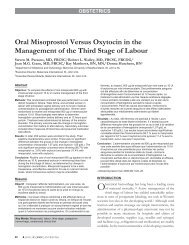Leung, Peter CK Titles - UBC Department of Obstetrics ...
Leung, Peter CK Titles - UBC Department of Obstetrics ...
Leung, Peter CK Titles - UBC Department of Obstetrics ...
- No tags were found...
Create successful ePaper yourself
Turn your PDF publications into a flip-book with our unique Google optimized e-Paper software.
Name:<strong>Titles</strong>:Degrees / Designations:Primary Area <strong>of</strong> Research:Secondary Area(s) <strong>of</strong> Research:Email:<strong>Leung</strong>, <strong>Peter</strong> C.K.Pr<strong>of</strong>essor, <strong>Department</strong> <strong>of</strong> <strong>Obstetrics</strong> & Gynaecology,University <strong>of</strong> British ColumbiaProgram DirectorReproductive and Developmental SciencesPhDReproductive HealthPhone: 6048752718Fax: 6048752717Laboratory Phone: 6048752361Assistant:peleung@interchange.ubc.caRoshni NairAssistant Phone: 6048753108Mailing Address:Room 2H30 4500 Oak St.Vancouver, BCV6H 3N1Research Areas· Reproductive biology· EndocrinologySummaryGonadotropinreleasing hormone (GnRH) is a key regulator <strong>of</strong> mammalian reproduction. After itsrelease from the hypothalamus, this decapeptide hormone is transported from the brain via theportal blood circulation to the anterior pituitary gland, where it stimulates the synthesis and release<strong>of</strong> the gonadotropins that play pivotal roles in the regulation <strong>of</strong> the gonads (i.e. ovary and testis). Inaddition, GnRH has been implicated as an autocrine regulator in several extrapituitary tissues,including the ovary and placenta, but the specific functions are still unknown. Numerous syntheticanalogs <strong>of</strong> GnRH are now being used in different areas <strong>of</strong> reproductive medicine, such as assistedreproduction. The longterm goal <strong>of</strong> my research program is to understand the multifaceted role <strong>of</strong>GnRH in reproductive health and medicine.Current ProjectsEndocrine control <strong>of</strong> reproductionThe aim <strong>of</strong> this project is to better understand the hormonal control <strong>of</strong> reproductive function byGnRH. Experiments are designed to test the hypothesis that, in addition to its wellknown role in theregulation <strong>of</strong> pituitary hormone secretion, GnRH is also an autocrine regulator <strong>of</strong> ovarian hormoneproduction. Further experiments are proposed to examine the regulation <strong>of</strong> the human GnRHreceptor, at the level <strong>of</strong> gene transcription. It is expected that this research will lead to a betterunderstanding on the cellular and molecular basis underlying the use <strong>of</strong> GnRH analogs in manydifferent areas <strong>of</strong> reproductive medicine, such as fertility and sterility, control <strong>of</strong> ovulation andassisted reproductive technology.Function <strong>of</strong> GnRH in endometrium and placentaThe establishment <strong>of</strong> a successful pregnancy is dependent on the coordinated development <strong>of</strong> theimplanting embryo and the lining <strong>of</strong> the uterus (endometrium). To date, the regulatory factorsinvolved in the development <strong>of</strong> a uterine environment that promotes embryonic implantation and/orthe formation <strong>of</strong> functional placenta remain poorly characterized. In this project, the regulation <strong>of</strong>GnRH in endometrial and trophoblast cells undergoing differentiation in culture will be examined. Abetter understanding <strong>of</strong> the role <strong>of</strong> GnRH and related hormones in implantation and placentation is
likely to reduce the number <strong>of</strong> couples assigned the frustrating and costly diagnosis <strong>of</strong> unexplainedinfertility.Normal and neoplastic ovarian surface epithelium endocrine and hereditary influencesThe epithelial ovarian carcinomas, which comprise over 85% <strong>of</strong> human ovarian cancers, arise in theovarian surface epithelium (OSE). The etiology and early events in the progression <strong>of</strong> thesecarcinomas are among the least understood <strong>of</strong> all major human malignancies because there are noappropriate animal models, and because methods to culture OSE have become available onlyrecently. The purpose <strong>of</strong> this project is to define the molecular mechanisms which underlie thecontrol <strong>of</strong> normal and neoplastic OSE cell growth, differentiation and expression <strong>of</strong> indicators <strong>of</strong>neoplastic progression, by GnRH and other key reproductive hormones. Also, the hormonalresponse <strong>of</strong> OSE isolated from overtly normal ovaries <strong>of</strong> women with and without family histories <strong>of</strong>ovarian cancer will be examined, in order to define the specific abnormalities in the OSE that lead toa high risk <strong>of</strong> developing ovarian cancer. The results <strong>of</strong> this research will be relevant to thedevelopment <strong>of</strong> more efficient chemotherapeutic methods for ovarian cancer treatment.Selected PublicationsKim KY, Choi KC, Auersperg N, <strong>Leung</strong> P<strong>CK</strong>. “Mechanism <strong>of</strong> gonadotropinreleasing hormone(GnRH)I and IIinduced cell growth inhibition in ovarian cancer cells: role <strong>of</strong> the GnRHI receptorand protein kinase C pathway. Endocrinerelated cancer 13:211220 (2006).Choi JH, Choi KC, Auersperg N, <strong>Leung</strong> P<strong>CK</strong>. “Gonadotropins activate proteolysis and increaseinvasion via protein kinase A and phosphatidylinositol3kinase in human epithelial ovarian cancercells”. Cancer Research 66:39123920 (2006).Choi KC, Jeung EB, <strong>Leung</strong> P<strong>CK</strong>. “Impact <strong>of</strong> environmental endocrine disruption in femalereproductive system for women’s health”. Current Medicinal ChemistryImmunology. Endocrineand Metabolic Agents 6:313 (2006).Choi JH, Choi KC, Auersperg N, <strong>Leung</strong> P<strong>CK</strong>. “Differential regulation <strong>of</strong> two forms <strong>of</strong> gonadotropinreleasinghormone messenger ribonucleic acid by gonadotropins in human immortalized ovariansurface epithelium and ovarian cancer”. Endocrine Related Cancer 13:641651 (2006).An BS, Selva DM, Hammond GL, RiveroMuller A, Rahman N, <strong>Leung</strong> P<strong>CK</strong>. “Steroid receptorcoactivator3 is required for progesterone receptor transactivation <strong>of</strong> target genes in response togonadotropinreleasing hormone treatment <strong>of</strong> pituitary cells”. Journal <strong>of</strong> Biological Chemistry281:2081720824(2006).Choi JH, Ota T, Gilks CB, Auersperg N, <strong>Leung</strong> P<strong>CK</strong>. “Immuno Localization <strong>of</strong>gonadotropinreleasing hormone (GnRH)I, GnRHI I and type1 GnRH receptor during folliculardevelopment in the normal human ovary”. J Clin Endocrin Metab 91:45624570 (2006).Cheung LWT, <strong>Leung</strong> P<strong>CK</strong>, Wong AST. “Gonadotropinreleasing hormone promotes ovarian cancercell invasiveness through cJun Nterminal kinasemediated activation <strong>of</strong> matrix metalloproteinase2and 9. Cancer Research 66:1090210910 (2006).<strong>Leung</strong> P<strong>CK</strong>, Choi JH. “Endocrine Signaling in ovarian Cancer”, Human Reproduction Update 13:143162 (2007).Wong AST, <strong>Leung</strong> P<strong>CK</strong>. “Role <strong>of</strong> endocrine and growth factors on the ovarian surface epithelium”.Journal <strong>of</strong> <strong>Obstetrics</strong> and Gynecology Research 33:316 (2007).Choi JH, Wong AST, Huang, <strong>Leung</strong> P<strong>CK</strong>. “Gonadotropins and ovarian cancer”, Endocrine Reviews28:440461 (2007).Honours & Awards
Honorary Pr<strong>of</strong>essor <strong>of</strong> the Institute <strong>of</strong> Zoology, Chinese Academy <strong>of</strong> Sciences, Beijing 2002presentDistinguished Scholar <strong>of</strong> the Michael Smith Foundation for Health Research 20012006Honorary Member <strong>of</strong> the Taiwan Society <strong>of</strong> Reproductive Medicine 1996presentInstitute Advisory Board Member <strong>of</strong> the CIHR Institute <strong>of</strong> Gender and Health – 2004presentCareer Investigator <strong>of</strong> the BC Research Institute for Children's & Women's Health 19882001Director <strong>of</strong> Ovarian Workshops, USA 19942000Director <strong>of</strong> the Society for the Study <strong>of</strong> Reproduction, USA 19951998President <strong>of</strong> the Canadian Fertility and Andrology Society 19961997Medical Research Scientist Award 19881993Research Group MembersSeHyung Park, DVM, MSc Graduate studentInSun Hong Graduate studentFengtao Shi – Graduate studentSong Ling Poon – Graduate studentJunling Chen – Graduate studentMan Tat Lau – Graduate studentWai Kin So – Graduate studentJungChien Chen Graduate studentDr. Qing Huang – Postdoctoral Fellow
















